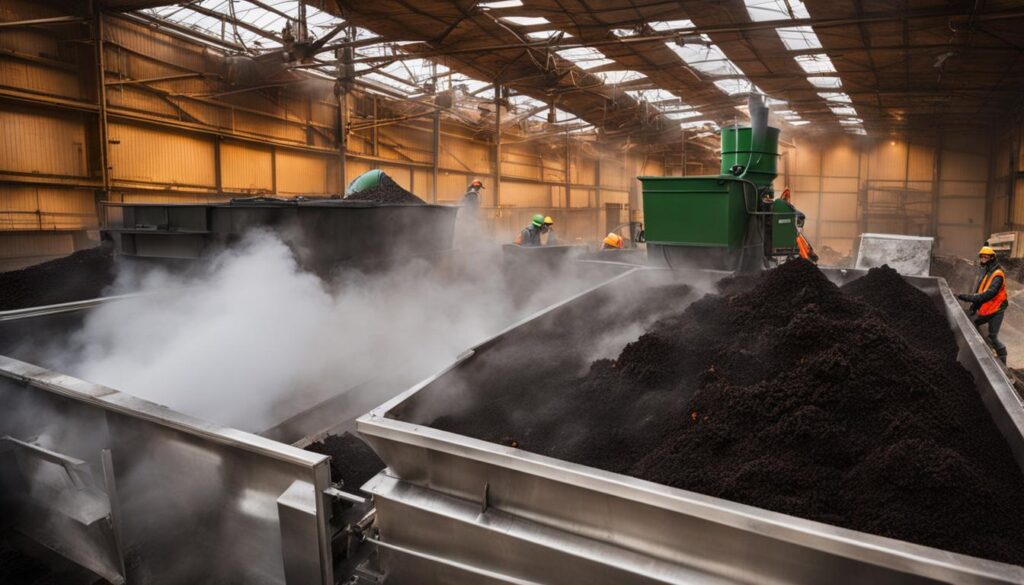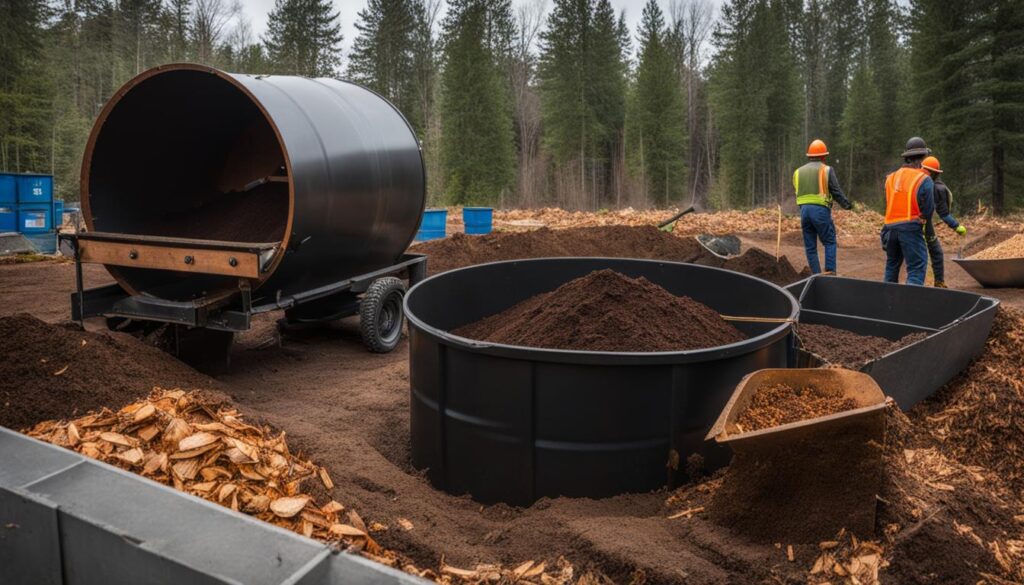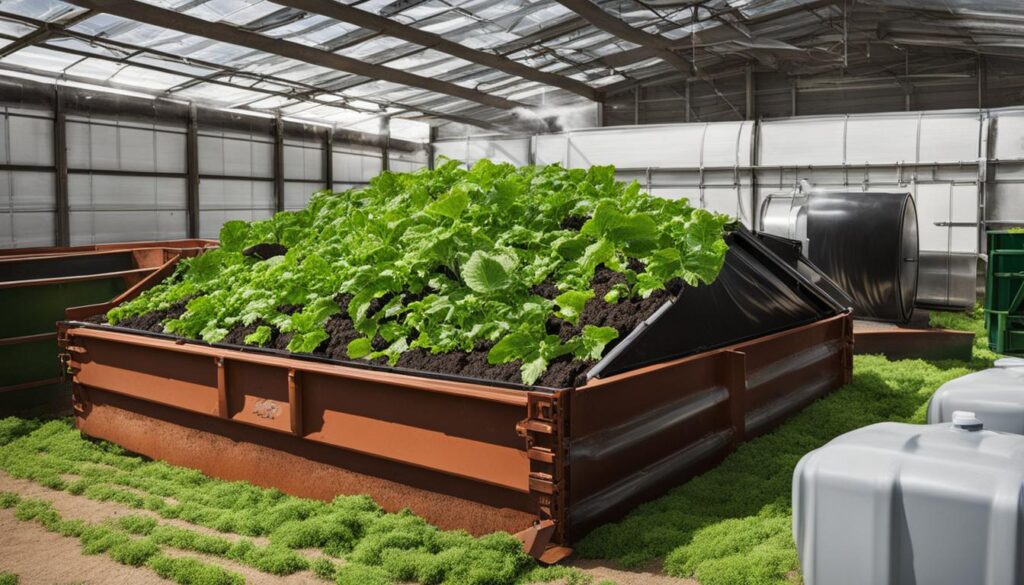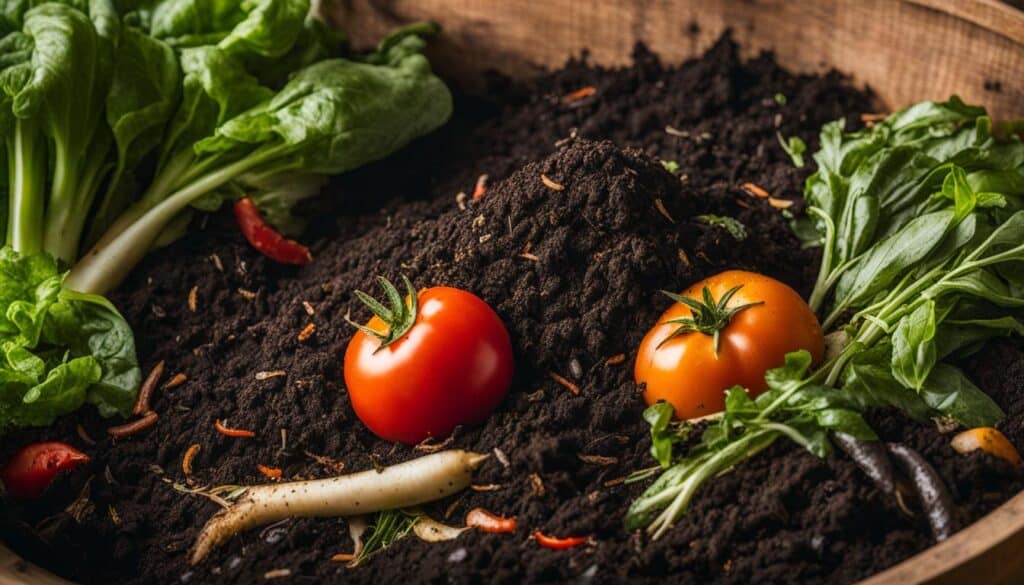At the gardenerstoolshed, we believe in the power of sustainable composting solutions that contribute to a greener future. That’s why we want to introduce you to the incredible benefits of in vessel composting. This eco-friendly method enhances soil health, reduces waste, and paves the way for a more sustainable future.
Unlike other composting techniques, such as windrow composting and anaerobic digestion, in vessel composting offers several advantages. It ensures high-quality compost, reduces the risk of contamination, and provides a faster composting process. By diverting waste from landfills, this method also plays a crucial role in waste reduction efforts.
In vessel composting is a significant step towards creating a more sustainable and environmentally friendly world. Join us as we delve into the details of this remarkable process and explore how it promotes organic waste management and soil improvement. Together, we can make a difference!
For More Composting Information Read This Blog Post: The Different Types Of Composting
The In-Vessel Composting Process
In vessel composting is a controlled and efficient process for decomposing organic waste in a controlled, aerobic environment. By creating the ideal conditions within enclosed containers or vessels, this method promotes rapid decomposition and the production of high-quality compost. The in-vessel composting process involves several key steps.
First, organic waste such as food waste, leaves, wood, and manure is loaded into the vessel. The waste is then mixed and aerated to ensure proper airflow and oxygen levels. This promotes the growth of aerobic microorganisms that break down the organic matter through the process of aerobic degradation. The decomposition process is accelerated in the controlled environment, resulting in faster composting compared to traditional methods.
The in-vessel composting process requires careful monitoring of temperature, moisture, and oxygen levels. Maintaining the optimal range of these factors is crucial to ensure the activity of microorganisms and the proper decomposition of the organic waste. By creating controlled conditions, in vessel composting minimizes the risk of contamination and produces compost that is free from pathogens and weed seeds.
| Advantages of the In-Vessel Composting Process | Challenges of the In-Vessel Composting Process |
|---|---|
|
|
Overall, the in-vessel composting process offers an effective and efficient solution for managing organic waste. It harnesses the power of controlled conditions and aerobic degradation to quickly convert organic waste into nutrient-rich compost. By implementing this process, we can contribute to a more sustainable future by reducing waste, improving soil health, and minimizing the environmental impact of organic waste disposal.
Types of In-Vessel Composting Systems
In vessel composting systems come in different types, each designed to optimize the composting process by controlling airflow, temperature, and oxygen concentration. Let’s take a closer look at the three main types of in-vessel composting systems:
1. Vertical Towers
Vertical tower composting systems are tall structures with multiple levels or trays for composting materials. These systems allow for efficient use of vertical space, making them suitable for areas with limited ground space. The composting material is loaded from the top and gradually moves down through each level as it undergoes decomposition. Vertical tower systems provide excellent aeration and control over temperature and moisture levels, resulting in faster composting and high-quality end products.
2. Horizontal Rectangular Tanks
Horizontal rectangular tanks, also known as conveyor belt systems, are long and wide containers that use a continuous mixing and aeration method. The composting material is loaded at one end and gradually moves through the tank on a conveyor belt, stirring and aerating the material as it progresses. This system provides consistent mixing and aeration, creating ideal conditions for decomposition. Horizontal rectangular tanks are commonly used in large-scale composting facilities where high volumes of organic waste need to be processed quickly and efficiently.
3. Circular Rotating Tanks
Circular rotating tanks, also referred to as drum composters, consist of a rotating cylinder or drum. The composting material is loaded into the drum, which rotates on an inclined axis. As the drum rotates, the material tumbles and mixes, ensuring proper aeration and decomposition. Circular rotating tanks provide excellent mixing and aeration throughout the composting process, resulting in a uniform compost mixture. These systems are suitable for both small and large-scale composting operations.
Differences between the Types of In-Vessel Composting Systems
| Type of System | Main Features | Applicable Scale |
|---|---|---|
| Vertical Towers | Tall structures with multiple levels or trays for composting materials | Small to medium scale |
| Horizontal Rectangular Tanks | Long and wide containers with a continuous mixing and aeration method | Large-scale |
| Circular Rotating Tanks | Rotating drums that provide tumbling and mixing of the composting material | Small to large scale |
Each type of in-vessel composting system has its own advantages and is suitable for different scales of composting operations. The choice of system depends on factors such as the volume of waste being processed and the available space for composting infrastructure.
Best Practices for In-Vessel Composting
In vessel composting requires careful control of various parameters to ensure optimal results. Here are some best practices to follow:
Temperature Control:
Maintaining the right temperature is crucial for the composting process. The ideal temperature range for in vessel composting is between 122°F and 140°F (50°C and 60°C) to support microbial activity. Regular monitoring of temperature levels using temperature probes or sensors can help adjust the composting process if needed.
Moisture Levels:
Proper moisture levels are essential for microbial activity and decomposition. The moisture content in the composting material should ideally be between 40% and 60%. Regular monitoring and adjustments of moisture levels using moisture meters or visual observation can help maintain the right conditions for composting.
Carbon to Nitrogen Ratio:
A balanced carbon to nitrogen ratio is necessary for effective decomposition. The ideal ratio is generally around 25 to 30 parts carbon to 1 part nitrogen (C/N ratio of 25:1 to 30:1). This ensures that there is enough carbon for energy and nitrogen for microbial growth. Adjustments can be made by adding carbon-rich or nitrogen-rich materials as needed.
Mixing and Aeration:
Proper mixing and aeration of the composting material promote oxygen flow and prevent the development of anaerobic conditions. Regular turning or agitation of the composting material helps distribute oxygen and improve the composting process. Mechanical systems can be used for larger-scale operations, while manual turning may be sufficient for smaller-scale composting.
Following these best practices can help optimize the in vessel composting process, resulting in high-quality compost and efficient waste management.
Environmental Impact of In-Vessel Composting
In-vessel composting has a significant positive environmental impact, primarily through waste diversion and the reduction of landfill space. By diverting organic waste from landfills, in-vessel composting helps reduce the amount of waste that decomposes and produces harmful methane gas. Methane is a potent greenhouse gas that contributes to climate change, so by processing organic waste through in-vessel composting, we can mitigate its emissions and work towards a more sustainable future.
Through the composting process, organic waste is transformed into nutrient-rich compost that can be used to enhance soil health and reduce the need for chemical fertilizers. This not only reduces the environmental footprint of waste management but also promotes the recycling and reuse of organic materials. By utilizing compost produced through in-vessel composting, we can improve nutrient cycling, foster healthy soil ecosystems, and reduce our dependency on synthetic fertilizers, which can have negative impacts on water quality and biodiversity.
“In-vessel composting plays a crucial role in waste management and environmental sustainability. By diverting organic waste from landfills and reducing methane emissions, we can work towards a greener future.” – Waste Management Expert
Furthermore, in-vessel composting helps conserve valuable landfill space. As landfills reach their capacity, finding suitable locations for new landfills becomes increasingly challenging. By diverting organic waste through composting, we can prolong the lifespan of existing landfills, reduce the need for new ones, and potentially repurpose the saved land for other sustainable initiatives. This not only benefits the environment but also helps address issues related to land scarcity and urban development.
| Environmental Impact of In-Vessel Composting |
|---|
| Reduces methane emissions |
| Diverts organic waste from landfills |
| Efficient use of landfill space |
| Promotes soil health and reduces the need for chemical fertilizers |
| Contributes to sustainable waste management practices |
The Challenges of In-Vessel Composting

In vessel composting offers numerous benefits for organic waste management and soil health. However, it also comes with its fair share of challenges that need to be addressed. These challenges include capital and running costs, energy consumption, and limited space requirements.
Implementing in vessel composting systems can have higher upfront costs compared to other composting methods. The technology and equipment required for controlled composting environments can be expensive to install and maintain. It is crucial to carefully consider the financial implications and long-term sustainability of such systems before implementation.
In vessel composting systems typically require a continuous power supply to maintain the controlled environment, which can result in increased energy consumption. This increased energy requirement should be taken into account when assessing the overall environmental impact and cost-effectiveness of the system.
Another challenge of in vessel composting is the limited space it may require. These systems often require additional areas for curing the compost and storing feedstocks. Space constraints can be a significant limiting factor, especially in urban or densely populated areas where land availability is limited.
Comparative Analysis of Challenges
| Challenges | Windrow Composting | Anaerobic Digestion | In-Vessel Composting |
|---|---|---|---|
| Capital and running costs | Low | High | High |
| Energy consumption | Low | High | High |
| Limited space requirements | High | Medium | High |
“The challenges of implementing in vessel composting systems, such as high capital and running costs, increased energy consumption, and limited space requirements, need to be carefully considered and addressed to ensure the successful implementation and long-term sustainability of such systems.”
Despite these challenges, advancements in technology and increasing waste management regulations are driving the future potential of in vessel composting. Overcoming these challenges will pave the way for more efficient and cost-effective systems, making them accessible to a wider range of users. By addressing these challenges and implementing in vessel composting systems, we can contribute to mitigating the environmental impact of waste and move towards a more sustainable future.
In Vessel Composting in Practice

Implementing in vessel composting systems has proven to be effective in various settings, including both commercial and community applications. Commercial composting facilities utilize in vessel systems to process large volumes of organic waste, such as food waste generated by restaurants and institutions. These facilities take advantage of the controlled composting process to produce high-quality compost, which is then sold as a valuable product for agricultural or landscaping use. By diverting organic waste from landfills and converting it into a beneficial resource, these facilities contribute to waste reduction and promote sustainable composting practices.
Community initiatives also embrace in vessel composting to manage organic waste on a smaller scale. Residential complexes, schools, and other community organizations can implement in vessel systems to compost their organic waste locally. This not only reduces the amount of waste that ends up in landfills but also provides an opportunity for individuals to actively participate in waste reduction initiatives. In vessel composting in community settings promotes environmental awareness and education while fostering a sense of responsibility towards the sustainable management of organic resources.
“In vessel composting is a valuable tool for waste management, contributing to a more sustainable future and a healthier environment.”
In vessel composting systems offer flexibility in terms of scale and can be tailored to meet the specific needs of different applications. They provide a reliable and efficient solution for organic waste management, ensuring that valuable resources are not wasted and instead used to enrich the soil and promote sustainable agricultural practices. Whether implemented in commercial facilities or community settings, in vessel composting plays a crucial role in waste reduction initiatives and helps us move towards a more sustainable and environmentally conscious future.
| Application | Description |
|---|---|
| Commercial Composting Facilities | Large-scale processing of organic waste from restaurants and institutions; production of high-quality compost for sale. |
| Community Initiatives | Composting organic waste on a smaller scale in residential complexes, schools, and community organizations. |
Key Takeaways:
- In vessel composting is implemented in both commercial and community settings.
- Commercial composting facilities use in vessel systems to process large volumes of organic waste and produce high-quality compost for sale.
- Community initiatives utilize in vessel composting to manage organic waste locally and promote waste reduction.
- In vessel composting offers flexibility in scale and contributes to a more sustainable future.
Future Potential of In-Vessel Composting
In-vessel composting holds immense potential for the future, driven by ongoing technological advancements and the increasing focus on waste management regulations. As we continue to develop new technologies and refine existing ones, the efficiency and cost-effectiveness of in-vessel composting systems are expected to improve, making them more accessible to a wider range of users. These advancements will not only enhance the composting process but also contribute to creating a sustainable future.
One area where technological advancements can make a significant impact is in reducing the capital and running costs of in-vessel composting systems. By developing more efficient equipment and streamlining the composting process, we can make these systems more cost-effective and attractive to businesses and communities alike. Moreover, advancements in automation and remote monitoring can help optimize operations and reduce the need for manual intervention, further improving the efficiency of in-vessel composting.
| Technological Advancements | Benefits |
|---|---|
| Innovative monitoring systems | Real-time data analysis and optimization |
| Improved aeration technologies | Enhanced oxygen supply for accelerated composting |
| Advanced temperature control | Optimal conditions for microbial activity |
| Energy-efficient designs | Reduced power consumption |
Another key driver of the future potential of in-vessel composting is the increasing emphasis on waste management regulations. As governments and regulatory bodies around the world become more focused on organic waste diversion and sustainable waste management practices, the demand for composting solutions like in-vessel composting is expected to grow. By complying with these regulations and adopting in-vessel composting systems, businesses and communities can contribute to reducing their environmental impact, promoting circular economy principles, and achieving waste management targets.
As we look ahead, it is clear that in-vessel composting has a bright future. With ongoing technological advancements and the evolving landscape of waste management regulations, we can harness the full potential of this composting method. By implementing in-vessel composting systems, we can contribute to a more sustainable future, where organic waste is effectively managed, valuable resources are recovered, and the environmental impact of waste is minimized.
Aditional Reading Recomendations:
- Lasagna Composting: A Sustainable Method for Soil Enrichment
- Boost Your Garden: The Magic of Compost Tea Unleashed
Conclusion
In vessel composting offers numerous benefits for organic waste management, environmental sustainability, and waste reduction. This method provides a controlled and accelerated composting process, resulting in high-quality compost while minimizing the risk of contamination. By implementing in vessel composting systems, we can contribute to creating a sustainable future and reducing the environmental impact of waste.
In vessel composting plays a crucial role in enhancing soil health and nutrient cycling. The resulting compost can be used to enrich soil, improve its structure, and promote plant growth. By utilizing this method, we can reduce the reliance on synthetic fertilizers and decrease the overall environmental footprint of waste management.
Despite some challenges such as higher costs and limited space requirements, advancements in technology and increasing waste management regulations are paving the way for the future potential of in vessel composting. As technology improves, the efficiency and cost-effectiveness of these systems are expected to increase, making them more accessible to a wider range of users.
Overall, in vessel composting is a valuable solution for waste management and environmental sustainability. By embracing this method, we can contribute to a healthier planet by reducing waste, improving soil health, and promoting the use of organic resources for a more sustainable future.



